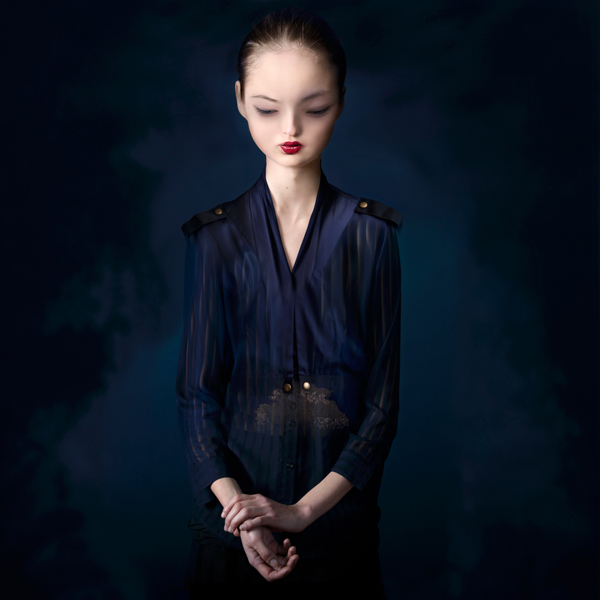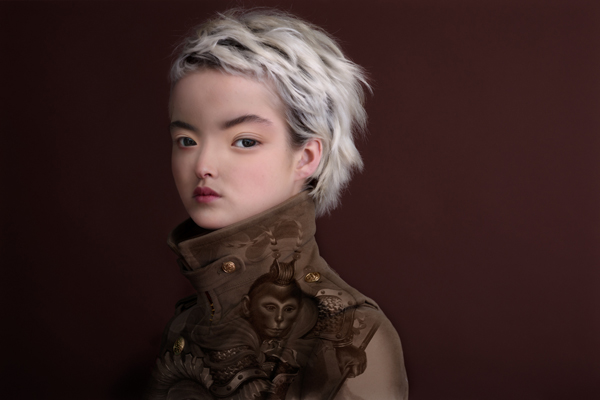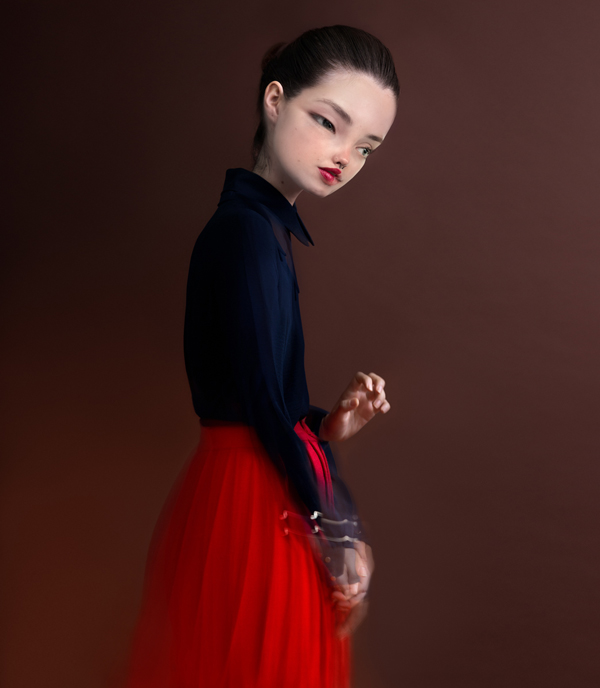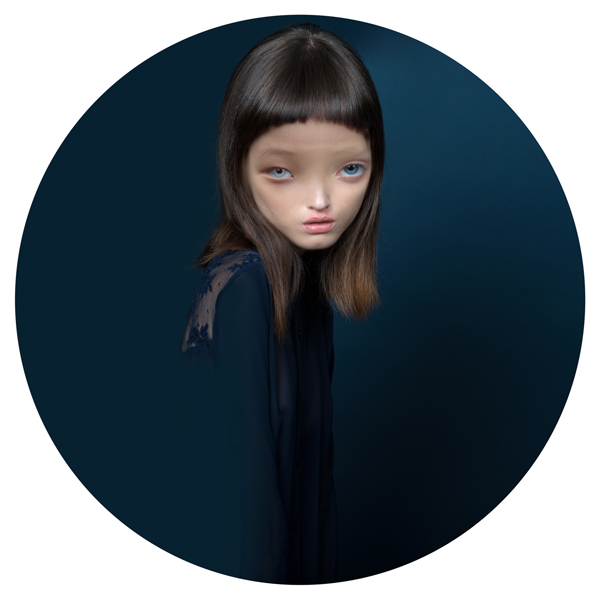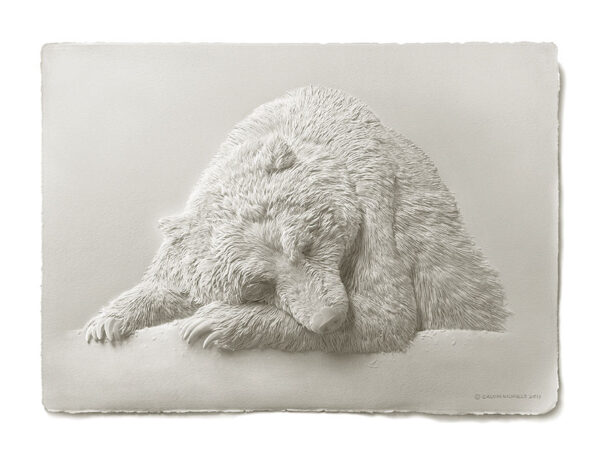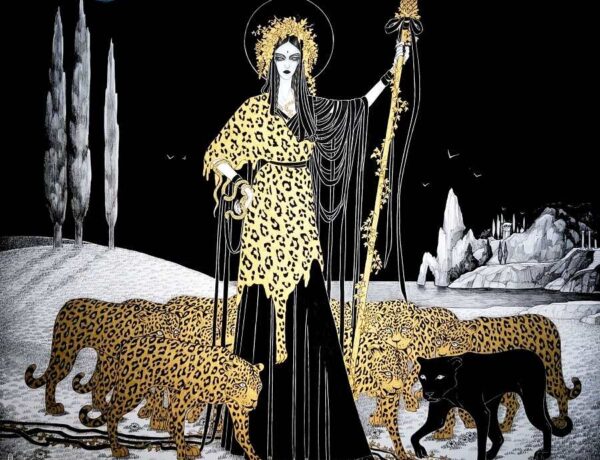“It is true, we shall be monsters, cut off from all the world; but on that account we shall be more attached to one another.” Mary Shelley, FRANKENSTEIN.
With an ingredients list that reads like a mad scientist’s experiment, Cecilia adds a dash of green eyes, a sprinkle of black hair and a dose of a wry smile to create her digital monsters. Cecilia Avendaño Bobillier is a fine artist from Santiago, who graduated with a major in Photography from the University of Chile. Her work wholeheartedly adopts a play with artifice sitting firmly in the arena of manipulated portraiture. Each subject is composed of a symphony of human elements to create a beautiful something, rather than an easier to digest, someone.
I had the pleasure of gaining further insight to Cecilia’s work in an interview. With a body of art that so deftly articulates the surface you’ll find that these glossy pools run deep as wells.
You can find out more about Cecilia and her flock of chimera at the Stephen Romano Gallery, USA.
Cecilia, let’s start with your creative process. I understand that you have photographic libraries of various facial features that you combine to create a new character. With hundreds of images used in each piece I’m wondering how much do you know about your characters before you start this process? Are you exploring your specimens to find a character’s parts or do they slowly reveal themselves to you in the process of searching?
I would say they slowly emerge during the searching process. My characters are invented. They come from the use and mix of different images that ultimately respond to my imagination. These imaginary personalities tell us something that, although inherent in any image, must be completed by each viewer who contributes their own stories and desires. Each image is related to something nonexistent, something that I cannot fully find in the real world. I don’t establish a symbolic relationship with my models as it takes hundreds of pictures to create each character. That relationship progressively evolves when the definitive face of my characters start to emerge from that mixture of images and digital intervention.
My creative process aims to fulfill my aesthetic fictions. It’s about images that produce oddness and that are related to otherness. I am interested in achieving the coexistence of the beautiful and the strange. In being able to produce agitation and seduction with a single image.
I loved hearing about your trip to Asia to gather new features. It almost sounds like a hunter/gatherer scenario. When you’re walking the streets or on a hunt, what makes someone’s features stand out? Is it something unusual, beautiful or obscure?
Traveling and visiting so many and diverse cultures was extraordinary. It made me realize how surprising and inspiring human nature is. In general, I always try to explore new perspectives of human nature with my work. That trip offered me more material to do new things following a line of work in which I have been working in recent years.
Also, I realized how increasingly interconnected the world is today, and how this expands our concept of beauty, giving space to difference and enriching the exchange of cultures.
I think that when you observe most of my photos you can either explicitly, or in a more subtle way, spot features that make each subject stand out and differentiate it. For me it is very important to discover those features in any individual. It is something that shows up for a small fraction of a second. That single moment is captured by my camera. Using the hunt analogy, it is like waiting and observing a face that at some instant unveils itself.
To me, your process is a large part of the work itself. You have those long sessions with your models with both of you knowing that the outcome will eventually be unrecognizable. It almost speaks to the fleeting nature of things, the ephemerality of life. It reminds me of intricate sand mandalas that get swept away after a day or the phoenix archetype where everything burns to ash and is resurrected as something new. Can you tell me more about this element in your work?
One of my favorite quotes from Proust says that “The human face is indeed, like the face of the God of some oriental theogony, a whole cluster of faces juxtaposed on different planes so that one does not see them all at once.”. Something like this is fundamental in my creative process and is what I want to develop with my work. The propagation of digital images, information, and their increasing interconnection is something positive for me. It is a fertile ground from which new things will emerge not only in terms of photo and artistic tendencies, but also in a wider human sense.
I think we are at the early stages of a process that will open up unimaginable perspectives for humans. In my work I try to shape this emerging state. I work from that place of saturation and exhaustion by using hundreds of photos to create a single character. I engage in the superabundance that characterizes modernity and the digital era.
There’s a very meticulous and conscious process of identity building in your work. Various parts are selected and revealed. On the one hand, modern practices of building brands or celebrities reflect this process. It’s very conscious and very contrived. On the other, humans as individuals seem so clumsy in their attempts to forge an identity. It almost always happens with an adolescent state of mind. Where do your subjects stand in regards to this? Is the process of creating identity humane or detached?
The process of identity building is deliberate and responds to the construction of an identity through aesthetics, advertising and fashion. My work cast doubts on the beauty standards in advertising. I believe in this revolution because I like diversity and finding beauty in difference.
I try to produce a dissonance when constructing the identity of my characters by mixing the beautiful with the ugly. The idea is that this disharmony leads the viewer to overcome her automatic reactions. The subjects that I create aim at provoking – through a series of subtle details – twisted perspectives, incomplete or duplicated features. This break in the symmetry that our mind expects, helps us to go beyond our concepts of what is pleasant, normal or aesthetically correct. I look for new ways to widen our views and enrich the way we relate with the world by questioning our judgement and identity.
Notions of the fragmented self and the schizophrenic nature of modern life has had a huge impact in Postmodern thinking. With so much stimuli and so many roles cast upon us I think we still haven’t shed this state of being. This fragmented self still seems so relevant today. Do you think we’re more comfortable with our kaliedescopic selves? Are your subjects comfortable with their fractures?
Every time we are in front a picture the idea of a fragmented reality is present. We are seeing something that exists or existed in one moment. Working under this principle has always interested me. In my previous works I developed this concept in an analogous way. Now, digital techniques have allowed me to address it from other complexities. For instance, the creation of characters that inhabit a reality that is limited to themselves. Subjects that simply exist and that are born from fragments of different images. This allows their escape from the basic principle of photography as they have no reference framework beyond the image itself.
I’m interested precisely in questioning all the things that can be affirmed through photography. In my work there is a double meaning. The fusion or mix of fragmented realities that have no context allows me to work under the principle of selection. The outcome is a picture, that although superficially artificial, keeps some features of humanity as it can be seen by certain organic factors such as the eyes, the hair, the corners of lips. Digital intervention does not cancel human latency. I think this duality makes the images both attractive and disturbing. We can guess the humanity behind the synthetic skin and the rigid poses.
We are increasingly pushed to build an identity that is multiple, changing and ultimately more fragmented. It is not anymore about a classic dichotomy, the one that arises when we look at ourselves in the mirror (our image vs the image that we have of ourselves), but the one that surges from the kaleidoscope, that fragments, divides, deforms and beautifies.
Beautiful monsters, mixtures of fantasy and nightmare. These fantasies and projections have now become almost palpable realities unlike before, where we only imagined them. I don’t think this is related to comfort, but it is about the time we live in.
The creator seems to love her Frankensteins… but do you want their audience too?
When I was working in my series Blow (2011), introducing the breathing mechanism to the image certainly reminded me of Frankenstein. This comes from an obsession that I have with my characters. Sometimes I would like them to talk to me, to tell me stories about the things that happen in their world, their desires or even to hear them breathe. I try to generate a reaction or a question from the viewers. My characters provide questions for the spectator to move them out of the indifference of what they see. This generates emotions that are either positive, negative, or both.
A strong theme in your work is the aesthetic of the monstrous. I love how subtly you handle this as I can’t quite pinpoint the “wrongness” of them. I’m curious as to what you think the most monstrous or repulsive parts of your characters are? I’ve come up with a couple of theories. One is that they are pure surface. With no history and no flesh they have an immediate disconnection from the viewer. I also see that they seem quite comfortable and confident with their forged and fractured selves. Maybe the biggest monster is a woman who creates her own identity rather than have one imposed on her by society. What’s your secret to monstrosity?
My images are driven by the imaginary that borders the limit of the monstrous and the deforming, but without losing the beauty that sneaks in to produce a feeling of weirdness. I think only the bizarre attracts attention. A characteristic that is fundamental in a world that is over-saturated with images. The violence of an image’s beauty works on different levels of reality and in my work there are many of these elements. It is by bringing to the surface these elements that weirdness is produced. It is the exercise of unveiling and getting rid of the masks that give my images its disturbing side. All the emotive marks are exposed and this is what makes them violent, but simultaneously generates a bit of empathy and beauty.
I’m also curious about the Chimera Vs Automaton element in your work. Chimera, like collages, seem to find their power in the separation between their parts. Their fractured nature is their loudest quality. On the other hand, automatons tend to imitate humans. Their various parts are glossed over and plasticized. A smooth artificiality is created. I see your characters more on the Automaton side of things which are often created to please humans rather than fight them. They even remind me of Japanese robots or sex dolls but I don’t quite trust that they’ll not attack me if they come to life. Do you see your subjects as closer to Chimera or Automatons?
Those concepts or aesthetic frameworks are created from multiple details that are included in my images. The use of clothing, tattoos, backgrounds, poses, and the hyper realism of some details like eyes which are in direct opposition to the artificiality of the skin. I maintain that each subject is different, even though they have a common identity. I utilize concepts such as androgynous bodies, the mixing of the savage and the ethereal, the use of advertising codes, artificiality and virtuality. These elements allow me to develop images that are close to my aesthetic references, which certainly include cyborg or sci-fi elements, and where you also can find the chimera and the automaton.
I wish I could have been there for your Blow (2011) show. I would have loved to of experienced the mechanical breathing canvases in real life. Do you think you’ll further explore a physical quality to your characters down the track? Something that takes them beyond the 2D?
Bringing to life my images through the use of a device created a closer link between the viewer and my characters. Producing images that breathe goes beyond using a trick or a mechanism. It has to do with bringing the characters closer to reality and offering the viewer more space for interpretation. We can attribute to the pictures a deep significance that leads them to think about what is real and what is illusory, about what we believe or want to see and what is actually represented.
I would like to keep experimenting in this line by incorporating elements of installation. I think that including movement or sound could make an important contribution to my work.
Cecilia, can you give me any hints of what you’re working on now? How do you see your style evolving? What are you inspired by? Any Frankensteins currently in the making?
I think that my style evolves as my discourse expands. Each time I finish a series a set of ideas emerge from discovering new things that are inspiring me or from the feedback that I receive from the visitors to my exhibitions. On the other hand, the evolution of my aesthetics has been more subtle, going from close-up in Pride (2008) to planes in which the body has a more relevant role with E.merge (2014). Overall, this is a long process because I need a space for experimentation before finding new things.
With respect to new Frankensteins, I’m currently working on some images that complete my latest series E.merge. Right now my inspiration comes from the microscopic world. I like the idea of showing two simultaneous realities in a single image: one that humans cannot see with a naked eye, and one to which we are very used to. Two coexistent realities that I want to put together in a single image.
I’m currently working on my coming three shows in NY, Barcelona and Chile.
You can find a bit more information about the places here:
New York: Stephen Romano Gallery
Barcelona: Galería Sicart
Chile: My work will be shown at Chaco Art Festival represented by Isabel Croxatto Gallery
You can stay up to date with my work on Facebook.


